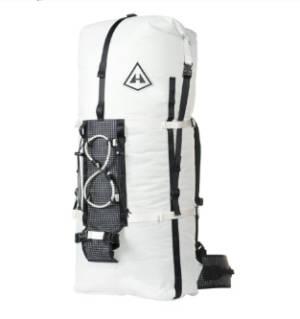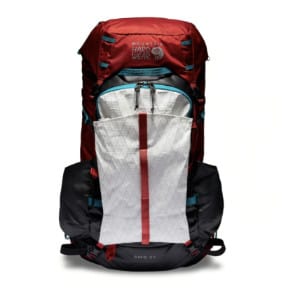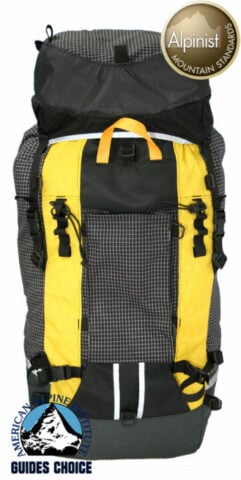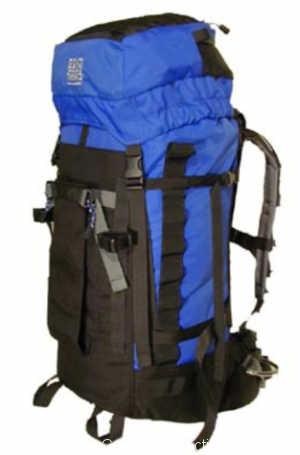
Winter backpacking packs are more specialized than regular three-season backpacks, with a stronger emphasis on heavier weight loads, external attachment points, and durability for carrying bulky gear with sharp points like snowshoes, skis, ice axes, and crampons. They also favor more pockets and the ability to access and put away gear quickly, so you can avoid standing around between gear transitions and getting cold. Pack volumes can vary anywhere from a minimum of 50L to 100L, with 65L usually being the sweet spot for a weekend trip.
Here are our picks for the top 10 best winter backpacking packs:
| Make / Model | Weight |
|---|---|
| Granite Gear Blaze 60L | 48 oz / 1361g |
| Osprey Mutant 52L | 52 oz / 1474g |
| Hyperlite Mountain Gear Ice Pack 70L | 37 oz / 1049g |
| Black Diamond Mission 75L | 65 oz / 1850g |
| Mountain Hardwear AMG 55 | 74 oz / 2098g |
| Gregory Denali 75L | 72 oz / 2041g |
| Mystery Ranch Scepter 50L | 56 oz / 1588g |
| Cilogear 60L Worksack | 67 oz / 1980g |
| Cold Cold World Chaos 66L | 60 oz / 1701g |
| Sierra Designs Flex Capacitor 60-80L | 50 oz / 1400g |
1. Granite Gear Blaze 60 Backpack
| Shop at REI | Shop at Backcountry |
2. Osprey Mutant 52L Backpack

| Shop at Osprey | Shop at Amazon |
3. Hyperlite Mountain Gear 4400 Ice Pack (70 L)
4. Black Diamond Mission 75L Backpack
| Shop at Backcountry | Shop at Black Diamond |
5. Mountain Hardwear AMG 55L
6. Gregory Denali 75L
| Shop at Backcountry | Shop at Amazon |
7. Mystery Ranch Sceptre 50 Backpack
8. Cilogear 60L Worksack
9. Cold Cold World Chaos 66L Backpack
10. Sierra Designs Flex Capacitor 60-80L
HOW TO CHOOSE A WINTER BACKPACK
Backpacks tailored for winter use have a different feature set than most 3 season packs. What follows are the features that I’ve found most useful for overnight and multi-day winter trips in mountainous terrain. While I think these translate fairly broadly across winter locales, you need to be the judge on the features you believe are most relevant for your needs.
Volume and Weight
If you mostly plan on doing overnight or weekend-length winter backpacking trips, you’ll probably want a pack that has 65-85 liters of internal capacity. The sweet spot is about 70 liters, but you might be able to shave that down as low as 60 liters if you carry less gear or need less insulation. Try to get a pack that has adequate compression so you can shrink its volume if not needed while keeping the weight of an empty pack under 5 pounds. Pack and gear weight is even more important in winter than the rest of the year because you’ll be wearing and carrying a lot more of it.
External Attachment Points
Winter packs need to have a multitude of external attachment points to carry sharp, pointy, or bulky gear that won’t fit inside the main storage areas of a backpack. The most useful external attachment points include compression straps, daisy chains, hip belt webbing or gear loops, and ice ax loops with shaft holders.
Compression Straps
Compression straps serve two purposes: to help compress a puffy load and bring the weight closer to your core muscles where it can be carried more easily; and to attach sleeping pads, snowshoes, avalanche shovels, or skis to the sides of your pack instead of the front, so that the load doesn’t pull you backward and off-balance.
When choosing a backpack, try to find ones that have two or three tiers of compression straps that run horizontally across the sides of the packs. The compression straps should be adjustable and easy to undo while wearing gloves so you can slide snowshoes under them. Avoid packs that have compression straps that zig zag back and forth on the backpack using one strap to save weight. These are very difficult to use.
Daisy Chains
Daisy chains are often sewn onto winter packs and can be used to lash extra gear to the back or sides of the pack using canvas or velcro straps. They usually have many loops sewn into them that run the length of your pack from top to bottom.
Ice Ax Loops
There are two kinds of ice axes in this world – straight walking axes and curved climbing axes. If you need to carry a walking ax, look for a pack that has at least one ice ax loop at the base of the pack and a shaft holder, both off-center along the back of the pack. The shaft holder can be a simple cord lock like those found on many Osprey packs, or a more robust buckle. If you plan on carrying two climbing axes, look for packs with two ice ax loops and shaft keepers.
Hip Belt Webbing and Gear Loops
Some climbing-oriented packs have canvas or plastic gear loops on the outside of the hip belt to clip climbing carabiners to. While not a substitute for a proper sit-harness, these loops can be quite convenient to rack gear. Alternatively, you can clip insulated water bottle holders to them so you can drink when you are on the move and don’t want to stop. Extra hip belt webbing serves the same purpose and is often better than having belt pockets that are too small for winter use.
Crampon Pockets
Crampon pockets are a very convenient and safe place to store crampons when you’re not wearing them. Located on the side of the pack farthest away from you, they keep the crampon points away from your arms and legs, your head, and your gear where they can do real damage.
Floating Lids
It can be very helpful in winter to have a backpack that can expand in volume to carry more gear. One way to do this is to buy a pack with a floating lid, usually a top pocket that can detach from the main body of the pack but is still held down by 4 straps. Extra gear, say a coil of rope, can be sandwiched between the pocket and the top of your pack in this manner.
Backpack Pockets
Backpack pockets can be a two-way street in winter. While they can be useful for organization, they can also add a lot of unnecessary weight to a backpack. For example, having a backpack with a separate sleeping bag pocket is pretty useless, because your sleeping bag can just as easily be stored in one large main compartment without needing the extra fabric weight and zipper required for the additional pocket.
Accessory Pockets
Most of the hip belt pockets provided by manufacturers are simply too small to be of much use in winter, and there aren’t enough of them to carry everything you might need for a winter hike, such as a camera, suntan lotion, lip balm, headlamp, compass, map, altimeter, and a pencil or pen. Many hikers add accessory pockets to their packs to provide more external storage or they wear an additional fanny pack backward to provide another pocket that can store spare gloves, hats, and food.
See Also:
- Winter Backpacks: The Good, The Bad, and The Ugly
- How to Attach Snowshoes to a Backpack
- How to Attach an Ice Axe to a Backpack
- Winter Backpacking Gear List Explained
 SectionHiker.com Backpacking Gear Reviews and FAQs
SectionHiker.com Backpacking Gear Reviews and FAQs 








Hey Phil,
The custom ski mod option is no longer available on Hyperlite Mountain Gear packs. HMG now offers the Headwall 55, a dedicated backcountry ski pack. Check it out!
Regards,
Tim (works for HMG)
You just need side compression straps to carry skis anyway. That pack is not there not because of the skiing, but because it has a crampon holder and volume.
Have you gotten a chance to check out the Headwall pack yet Phil? Was curious If I could use it for winter backpacking as well as backcountry skiing!
Looks great for skiing. You’ll probably have a hard time fitting winter backpacking gear into it though if you have to carry a 0 degree bag. It’s doable, but you’ll need a trash compactor to get it to all fit! Now, if you can stay at a cabin carry a lighter bag, go for less time, not need to melt snow that might be doable. etc.. My chief concern is that avy pocket in the front. Not sure if that’s usable for much gear storage if you actually need to carry avalanche safety equipment. People underestimate how hard it is to pack for winter backpacking.
I saw on you’re most recent winter gear list that you mentioned you have a 3400 Southwest that you were using for winter backpacking. I actually have that pack already and generally use it for longer food carriers and more comfort orientated trips. Is it still the case that you are using that pack successfully? I am dipping my toes into winter backpacking but don’t have the necessary experience to know If I should be looking for another pack at this point in time. Also, where do you mount your snowshoes in the 3400 Southwest?
Winter is only about a week old here. Not exactly sure what I’ll be using this year as a winter pack. I suspect it will be the Mutant 52, the Chaos 66, or the Mission 75 minus a few parts. It won’t be the 3400. The problem is that I have too much choice and a huge backlog of pack reviews to get through this winter. I really have a backpack problem. :-)
The way you attach snowshoes to a 3400 is with cord and cordlocks. Find some anchors on the outside of the pack and rope them up. You might also be able to carry them under the Y-strap on top. When choosing a winter pack, the biggest variable to consider is access. The problem with a lot of rolltops is that they don’t have very good external storage to hold spare gloves, food, hats, and face protection. If you use a rolltop, Id seriously look into getting some extra chest storage to hold that stuff. That’s one of the benefits of a top lid in winter.
Great post. Perfectly timed. I’m looking for a winter pack now. You have the best winter content Philip!
I have learned a tremendous amount from your website and still continue to. Thank you! There are limited stores left that sell equipment so I find your site invaluable. I really struggle with weight (haha)I know this article is backpacking but I struggle just with the day hiking weight along with the overnight weight. I started hiking again two years ago after taking 25 years off. I am sure most people here are more experienced than I am, I have only done about 3/4 of the 4000 footers and I really only hike from late fall to early spring and I almost always hike solo. I don’t like the heat or the crowds. In the middle of the winter my day hiking pack can approach 45lbs (snowshoes, crampons, 3 L water, just in case sleeping sleeping bag, pad etc) I have an old Jandd backpack that is 85-100l but it weighs 7 lbs. I don’t have much experience with different packs but I hike for 10 hours with 40lbs and my back, shoulders and hips don’t hurt which I assume is good, I typical don’t even take it off when I rest. I do often have to tighten the waist strap though. The blaze 60 looks nice and I think it would be great for a winter daypack for me,I wish I could find a store that I could try it on at. I would like to do more winter backpacking though and even 70 liters seems too small to me for overnights. I am amazed how little some people bring in the winter even for day hikes. I am sure with more experience I will learn how little I can bring and still be safe but that is where I am still lacking. Do you have any suggestions on larger packs?
Return policies. Order it. Try it on at home. Return it if it doesn’t work. But I’d also consider just bringing less stuff. I solo winter day hike in the whites up and down 4000 footers every other day with a 38L pack (granite gear no longer made) that has excellent external storage like the blaze. I’m just really careful about the weather and check trail conditions. I do carry emergency gear too. a foam pad, insulated pants and a parka 4 pairs of gloves, 2L of water, lots of food, water purifiation tablets, fire starter, face protection, sometimes waders depending on the route, and an inReach mini 2. I’m confident that I could survive if I had to spend the day out. But like I said…I’m just really conservative with weather conditions, especially above treeline. It’s true, many people do carry too little on winter day hikes in the Whites and they don’t check the weather. But when the shit hits the fan….they’ll have a hard time of it. If you do want a bigger pack, I’d look at the Ospreys like the Atmos and Aether, of the Gregory Baltoro, but I do think they’re a bit overkill. For example, pack for livability not comfort. You simply don’t need a -20 bag if you only day hike when its 10 degrees or warmer.
I am sure you are correct. I do check the weather for a day hike especially the expected weather for the night after the hike in case I got stuck out. I am sure I could use a smaller pack for day hikes though I would struggle to get to 38l but for backpacking for a night or two it would be hard to bring less. I also find at 6’3 well over 200lbs some of the stuff is just bigger. The long sleeping bag, xxl jackets, the 12oz tails for the evo snowshoes. I have learned every time I orders something with a size to add 10%-20% to the weight listed (I assume they quote medium). You are spot on with the packing for livability and not comfort. I definitely need to do a better job on day hikes but planned overnight if I am not comfortable I loose interest. Thanks again for the great site.
I tried the Blaze 60 and between my own ignorance on fitting a new style pack and lack of fitting information from the manufacturer it seams that it does not fit me. I love the side/water bottle pockets. I was wondering if you anyone had any opinions on the Big Agnes Parkview 63l or the Osprey Aether Pro 70 (I wish it had daisy chains) the Bridget 65 looked nice also albeit heavier.
I love your reviews, great site. I am just curios it seems like the Cold Cold Chaos is one of your favorites. Why is it not number 1. I tried the Blaze 60 L but it weighed 3lbs 10 oz while not a lot more I get annoyed when it is that much deferent than advertised
Because packs with more rigid frame are much easier to pack and use. The Chaos is a great pack but packing it, because its frameless, is a bit nuanced and takes a lot of practice.
Hi Philip – thanks as always for a great roundup!
I was curious – what keeps all the Seek Outside packs off the list? They seem to have many of the features you’re looking for – volume/weight capacity, external attachment points, durable fabric.
Good question. Most of hese packs have a “climbing” or skiing” orientation that makes them more agile to use in winter/mountaineering conditions where you want a backpack that “moves with you”. While I have used Seek Outside packs for winter hiking and backpacking in the past, the external frame component is a little too boxy and stiff for winter hiking. It’s a subtle distinction, but when push comes to shove that’s the reason.
Thanks, that makes a lot of sense.
Waymark 60L is my Winter Pack. Best in my view
No Seek Outside?